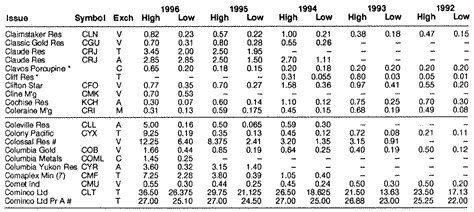Several years ago, I bought a copy of the Canadian Mining Handbook, published by the Northern Miner, Canada's premier mining newspaper. I flipped to the back, where they publish the 5-year trading results all mining stocks. While scanning these, I noticed an incredible pattern...
The juniors fluctuated in price crazily from year to year, with the "high for the year" often being 3-4 times the low, and sometimes as high as 10-50 times the low! They did it almost every year. ...And they rarely died.
I can remember laughing and said (to no one in particular), "Well, it seems to me the idea is to ignore the psychological hysteria that causes these patterns and just buy low and sell high."
But I also thought that it couldn't be that simple. It wasn't, of course.
But it WAS the beginning. Over time, I developed a rigorous system (which we now call PennyGold) that:
I put aside $5,000, which I was totally prepared to lose to test this strategy. Well, it didn't lose. In six years, that original $5,000 has grown by over $150,000! And by only spending an hour or two per week on it!
Let me give you an idea of what I saw in the Canadian Mining Handbook. This random selection, scanned from the 1997-1998 edition, shows the 5-year trading results for twenty mining stocks.

Note that the penny stocks (those with lows for the year of under $0.30) fluctuate much more wildly than the large, established companies. They cycle like this year after year after year. Even when they finally disappear, it's often because they simply reorganize under a different name (which is what the * means besides Cliff Res's name in the table).
Take a look (in the table above) at companies like Coleville Resources, which jumped from 6-and-a-half cents to 50 cents during 1995, then sank to a low of 16 cents in 1996, before finally soaring to $5.00 later in 1996! And what about Colony Pacific, which exploded from 19 cents to $9.25 during 1996!
Why do they fluctuate so crazily? Because it's a market where "greed-then-grief" psychology rules 97% of the players. Believe it or not, there really are people who bought Colony Pacific at $9.00+ in 1996 -- as of this writing (May, 1998), it sells for $0.20! (If you'd like to check its price the symbol is CYX in Toronto).
Would you rather play in the senior markets, where the experts are extremely sharp and where the fluctuations are minimal? Or would you rather invest in the junior markets, where your competitors are generally dumb and volatile, and where there are terrific profits to be made?
If you answered "the juniors," PennyGold not only shows you how to make serious money by investing INTELLIGENTLY in penny mining stocks, it gives you all the tools to go out and DO IT ... immediately.